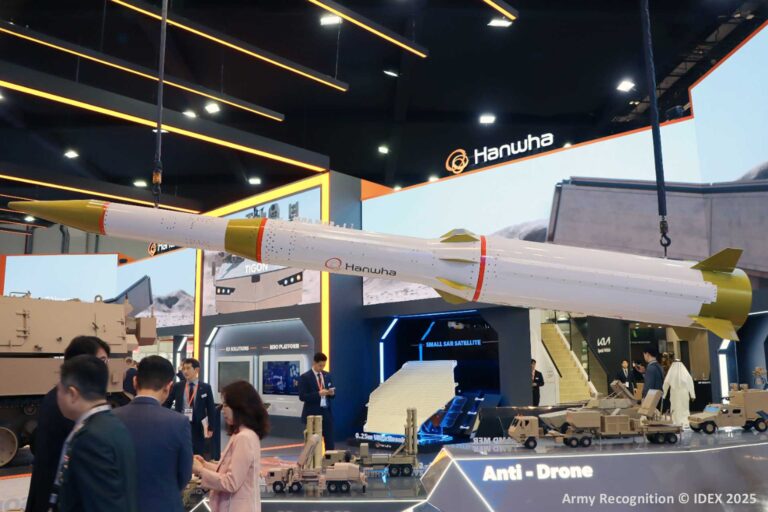In IDEX 2025, Hanwha Aerospace is engaged in the development and export of advanced air defense systems, focusing on dealing with evolving missile threats. The company has signed several agreements with Middle Eastern countries, including the United Arab Emirates (UAE) and Saudi Arabia, to provide air defense capabilities. In addition to medium-range surface-to-air missile (M-SAM) systems, HANWHA is working towards the deployment of long-range surface-to-air missiles (L-SAM), a system that is functionally similar to US Terminal High. . Advanced Area Defense (THAAD) is designed to counter the ballistic threats of high altitudes.
Follow the Army Recognition on Google News at this link
In IDEX 2025, Hanwha Aerospace presents the L-SAM, an upper missile defense system designed to intercept ballistic threats at altitudes of 50-60 km. (Photo source: Army recognition)
The UAE signed an agreement for the M-SAM system in 2022. This is also known as Cheongung (Sky Arrow), which was developed in collaboration with the South Korean Defense Development Agency (ADD). Valued at around US$3.5 billion, the deal involves Hanwha Aerospace, which supplies missile launchers, propulsion systems and transport vehicles, and Hanwha Systems will provide multifunctional radar (MFR) for target detection and tracking. did. Hanwha Aerospace says its approach goes beyond providing industrial cooperation to air defense systems, including training, maintenance support and potential technology transfers, to client countries. The standard M-SAM battery consists of a mobile radar, a command post vehicle, and four launchers, each carrying eight missiles fired vertically in a canister.
Also known as KM-SAM, Cheolmae-2, or Cheongung, the M-SAM is a South Korean medium-range interregional missile system developed to replace the aging MIM-23 Hawk system within South Korea’s atmosphere and missile defense. (KAMD) Framework. Development will begin in 2001, Block-I will be completed in 2011, Block-I will be completed in 2017, Block-II will be scheduled to begin development in 2024. Navigation, mid-course updates, terminal active radar homing to guide both aircraft and ballistic missiles. Block-I entered service in 2016 with a 40km range and 15km flight ceiling, but Block II, introduced in 2021, expanded the range to 50km, increased the intercepted altitude to 20km. Max speed achieved Mach 5. The system is designed to guide up to six targets simultaneously, including electronic warfare countermeasures.
The UAE has obtained the M-SAM block-II variant. It features improved maneuverability and hit capabilities against ballistic missiles. The system operates within a range of 20-50 km, with a maximum missile speed of 15-40 km intercepted altitude and a Mach 5 (1.7 km/s) depending on the target type. Following the acquisition of the UAE, Saudi Arabia and Iraq issued additional orders for M-SAM II in 2023 and 2024, respectively.
Hanwha Aerospace is also developing L-SAM, an upper missile defense system designed to intercept ballistic threats at altitudes of 50-60km. The system employs a hit-to-kill interception method and is designed to integrate with low-rise air defense systems. Developed by HANWHA Systems, L-SAM Multifunction Radar (MFR) offers a variety of aerial threat tracking capabilities, including ballistic missiles, aircraft and cruise missiles. The engagement process involves multiple steps, from initial detection and tracing to missile launches and final intercepts, where everything is managed through command and control systems. L-SAM’s guidance and propulsion technology is optimized for high-level interception with precision engagement capabilities. Mass production is planned for 2027, following the development and testing phases expected to end in the second half of 2024. HanwhaAerospace is also working with ADD to the next generation system, the L-SAM II, under the state project. The L-SAM II, which is expected to be completed by 2028, aims to increase defense coverage by 3-4 times compared to existing systems, with increased interception capabilities at higher altitudes.
At IDEX 2025, Hanwha Aerospace exhibited additional air defense systems along with KM-SAM, including hybrid short-range air defense (H-Shorad) and mobile anti-drone systems. The H-Shorad is a wheeled vehicle with a 30mm/40mm unmanned turret, a surface-to-air missile system and 3D AESA radar. It is designed to track and engage small UAVs and other airborne threats in a variety of terrain and weather conditions. Mobile anti-drone systems are designed to detect and identify small, low-flight unmanned aerial vehicles (UAVs), providing multi-layered responses at various distances. It includes jammer technology, a drone capture mechanism, and a laser system that can neutralize UAVs at altitudes of 1-3km. The system is designed to deploy infrastructure such as government buildings, airports, and oil refineries to protect against threats from drone herds and small UAVs.


